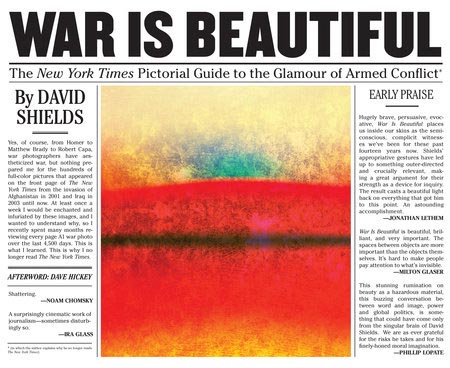 |
War Is BeautifulBy Ben Chitty (reviewer)War Is Beautiful: The New York Times Pictorial Guide to the Glamour of Armed Conflict
So, why should anyone outside the War Department (or a Legion hut with an open bar) want to produce a coffee-table-sized book called "War Is Beautiful?" Author David Shields explains: "For decades, upon opening the New York Times every morning, and contemplating the front page, I was entranced by the war photographs." On reflection, he realized that the function of these photos was "to sanctify the accompanying descriptions of battle, death, destruction, and displacement." After gathering and contemplating hundreds of these images, he confirmed his intuition: "the governing ethos was unmistakably one that glamorized war and the sacrifices made in the service of war." It turns out that this book does not just reproduce beautiful photographic images captured during our post-9/11 wars, it indicts the New York Times itself for complicity in the crime of war. In the history of human art, war or combat photography is a very recent category. Matthew Brady's photographs of Civil War battlefields created the genre; Robert Capa's photos from the Spanish Civil War and WWII set the modern standard. Conventions changed over time as photographic technology changed. As Susan Sontag observed in her essay, "Looking at War" (The New Yorker, December 9, 2002), early photographs were posed and almost painterly in their composition, while later lighter cameras permitted candid "action"shots, which were widely understood to be closer to the reality of the immediate moment, and somehow more truthful. Since battles and wars had traditionally been depicted in literature and art as noble and heroic, these photographs could be quite subversive. Television coverage of the American war in Vietnam created another change in war photography. Mobile movie cameras brought the war into the living room on the nightly news. The political effect was significant enough to teach the War Department that one lesson learned from Vietnam is to censor media coverage of wars, a strategy developed for invasions of Panama, Kuwait, Somalia, Afghanistan and Iraq. The Times made itself a player in this propaganda campaign; in short, the "newspaper of record" has lied about all these wars, and still lies. Some are lies of commission — the repetition of fraudulent intelligence about weapons of mass destruction, for example. Some are lies of omission — how would a Times reader learn that NATO is moving military forces up to Russia's borders, or that the elected government of Ukraine was overthrown by fascists with State Department connivance? So what about these beautiful pictures? They treat themes ranging from evocations of Michelangelo's Pietà to Love and Death, and quite beautifully indeed. It is especially interesting to compare the published captions with the photographers' descriptions of the image as recorded in the images' metadata. It is even more astonishing to contemplate the endpapers, which display all 64 front pages where the images appear above the fold and almost always centered. The takeaway is expressed in the book's subtitle: "The New York Times Pictorial Guide to the Glamour of Armed Conflict (In Which the Author Explains Why He No Longer Reads the New York Times)."Check out how the author glams up "glamour!" This is a coffee-table book. It lists for $39.95. Buy it if you will, but then give it to your local public library. Ben Chitty is a shellback Navy veteran of two deployments to Vietnam, a long-time member of Vietnam Veterans Against the War, and a librarian.
|


